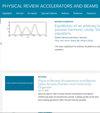Ultrahigh impedance method to assess electrostatic accelerator performance
Physical Review Special Topics-accelerators and Beams
Pub Date : 2015-06-30
DOI:10.1103/PHYSREVSTAB.18.060101
引用次数: 3
Abstract
This paper describes an investigation of problem-solving procedures to troubleshoot electrostatic accelerators. A novel technique to diagnose issues with high-voltage components is described. The main application of this technique is noninvasive testing of electrostatic accelerator high-voltage grading systems, measuring insulation resistance, or determining the volume and surface resistivity of insulation materials used in column posts and acceleration tubes. In addition, this technique allows verification of the continuity of the resistive divider assembly as a complete circuit, revealing if an electrical path exists between equipotential rings, resistors, tube electrodes, and column post-to-tube conductors. It is capable of identifying and locating a “microbreak” in a resistor and the experimental validation of the transfer function of the high impedance energy control element. A simple and practical fault-finding procedure has been developed based on fundamental principles. The experimental distributions of relative resistance deviations (ΔR=R) for both accelerating tubes and posts were collected during five scheduled accelerator maintenance tank openings during 2013 and 2014. Components with measured ΔR=R > 2.5%were considered faulty and put through a detailed examination, with faults categorized. In total, thirty four unique fault categories were identified and most would not be identifiable without the new technique described. The most common failure mode was permanent and irreversible insulator current leakage that developed after being exposed to the ambient environment. As a result of efficient in situ troubleshooting and fault-elimination techniques, the maximum values of jΔR=Rj are kept below 2.5% at the conclusion of maintenance procedures. The acceptance margin could be narrowed even further by a factor of 2.5 by increasing the test voltage from 40 V up to 100 V. Based on experience over the last two years, resistor and insulator failures are less common now due to the routine use of the noninvasive ultrahigh impedance technique.评价静电加速器性能的超高阻抗法
本文介绍了对静电加速器故障解决程序的研究。介绍了一种诊断高压元件故障的新技术。该技术的主要应用是静电加速器高压分级系统的无创检测,测量绝缘电阻,或测定柱柱和加速管中所用绝缘材料的体积和表面电阻率。此外,该技术还可以验证电阻分压器组件作为完整电路的连续性,揭示等电位环、电阻、管电极和柱柱-管导体之间是否存在电路径。它能够识别和定位电阻器中的“微断”,并对高阻抗能量控制元件的传递函数进行实验验证。在基本原理的基础上,开发了一套简单实用的故障查找程序。在2013年和2014年的5次加速器维护罐开启期间,收集了加速管和加速柱的相对阻力偏差(ΔR=R)的实验分布。测量到ΔR=R > 2.5%的部件视为故障,并进行详细检查,对故障进行分类。总共确定了34种独特的故障类别,如果没有新技术,大多数故障将无法识别。最常见的失效模式是绝缘子暴露于环境后产生的永久不可逆的漏电。由于有效的现场故障排除和故障消除技术,在维护程序结束时,jΔR=Rj的最大值保持在2.5%以下。通过将测试电压从40 V提高到100 V,可进一步缩小2.5倍的接受裕度。根据过去两年的经验,由于非侵入性超高阻抗技术的常规使用,电阻和绝缘体故障现在不太常见。
本文章由计算机程序翻译,如有差异,请以英文原文为准。
求助全文
约1分钟内获得全文
求助全文
来源期刊
自引率
0.00%
发文量
0
审稿时长
3-8 weeks
期刊介绍:
Physical Review Special Topics - Accelerators and Beams (PRST-AB), is a peer reviewed, purely electronic journal, distributed without charge to readers and funded by contributions from national laboratories. It covers the full range of accelerator science and technology: subsystem and component technologies, beam dynamics; accelerator applications; and design, operation, and improvement of accelerators used in science and industry. This includes accelerators for high-energy and nuclear physics, synchrotron radiation production, spallation neutron sources, medical therapy, and intense beam applications.

 求助内容:
求助内容: 应助结果提醒方式:
应助结果提醒方式:


